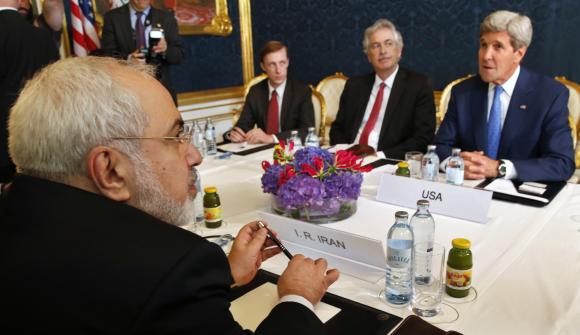 Iran's Foreign Minister Javad Zarif (L) holds a bilateral meeting with U.S. Secretary of State John Kerry (R) on the second straight day of talks over Tehran's nuclear program in Vienna, July 14, 2014.[/caption]
Iran's Foreign Minister Javad Zarif (L) holds a bilateral meeting with U.S. Secretary of State John Kerry (R) on the second straight day of talks over Tehran's nuclear program in Vienna, July 14, 2014.[/caption]LAUSANNE, Switzerland Iranian and American negotiators on Tuesday tackled some complex technical issues related to Irans nuclear program, but officials continued to speak of wide differences, dimming the prospects for an agreement this week.
Secretary of State John F. Kerry and Iranian Foreign Minister Mohammad Javad Zarif met for about six hours on Tuesday, joined by teams of experts that included nuclear physicists and specialists in sanctions and arms control.
A senior Obama administration official said some difficult issues still lie ahead as negotiators try to reach an agreement by March 31 on the outlines of a deal to limit Irans nuclear program and ease sanctions. A final deal is to be completed by late June.
We have definitely made progress in terms of identifying technical options for each of the major areas, the official said, speaking on the condition of anonymity under ground rules for briefing reporters. There is no way around it. We still have a ways to go.
The head of Irans nuclear agency was more upbeat, however, expressing optimism that the self-imposed March 31 deadline would be met.
Ali Akbar Salehi, a nuclear engineer who trained at the Massachusetts Institute of Technology, said that only one essential item remained on the table.
I can say, as a whole, I am optimistic, he told reporters in Lausanne, without providing specifics.
His assessment was even more positive in remarks to Iranian state TV. The main issues have been closed, he said.
But negotiators have reported progress at each round of talks over several months now, and there are no indications that they are preparing to wrap things up in the coming days.
The foreign ministers of the other five countries negotiating with Iran Britain, France, Germany, China and Russia are on standby to come to Lausanne this week, but it is uncertain whether they will be called. If they come, it would be a clear signal that an agreement was near.
Meanwhile, Kerry has commitments in Washington early next week, and Zarif is expected to return to Iran on Friday on the eve of Nowruz, the Persian new year.
U.S. officials have cautioned that even if a tentative agreement is reached on many details, the remaining differences could scuttle the chances for a final deal. The talks are now in a highly technical stage, as the sides juggle various formulas for restrictions on Irans nuclear program.
In the last three rounds of talks, Kerry has been joined by Energy Secretary Ernest Moniz, who previously led the physics department at MIT and was a young teacher when Salehi was there working toward his PhD in nuclear engineering. Their paths never crossed on the Cambridge, Mass., campus, however.
Iran has maintained that its nuclear program is intended only for the peaceful production of energy and medical isotopes. But the United States and its negotiating partners want to ensure that Iran does not have the capability of amassing enough fissile material to make a nuclear warhead. The United States is aiming to have a one-year breakout period, defined as the time Iran would need to produce the fissile material for one nuclear bomb. Officials say that is double what many experts consider necessary.
To that end, the United States has built models to check whether each option meets the test of providing at least a one-year notice of any possible violations.
The senior administration official said the other countries negotiating alongside the United States also have run their own models, producing similar results. It is unclear what Iranian research shows.
We are always looking at making sure any combination of options viewed as viable offsets our red line of a year breakout, the official said. A lot of things are linked. If something is given here, its got to be offset somewhere else.
Another hurdle is deciding the pace at which sanctions would be eased if Iran meets its commitments and allows more rigorous compliance visits by international nuclear inspectors. Iran is under separate sets of sanctions imposed by the United States, the European Union and the United Nations.
The United States and its European allies want sanctions eased gradually, while Iran is pushing for quicker relief.
Iranian President Hassan Rouhani said Tuesday that his country would continue to produce more oil and gas despite Western sanctions. On Monday, Irans oil minister said the country was prepared to export up to 1 million more barrels of oil a day once sanctions are lifted, though that is not considered enough to have a large effect on oil prices.
This article was written by Carol Morello for The Washington Post on Mar. 17, 2015. Carol Morello is the diplomatic correspondent for The Washington Post, covering the State Department. She previously wrote about demographics and the census. She has worked at the Washington Post since 2000. Before that, she was a reporter for the Philadelphia Inquirer and USA Today.










